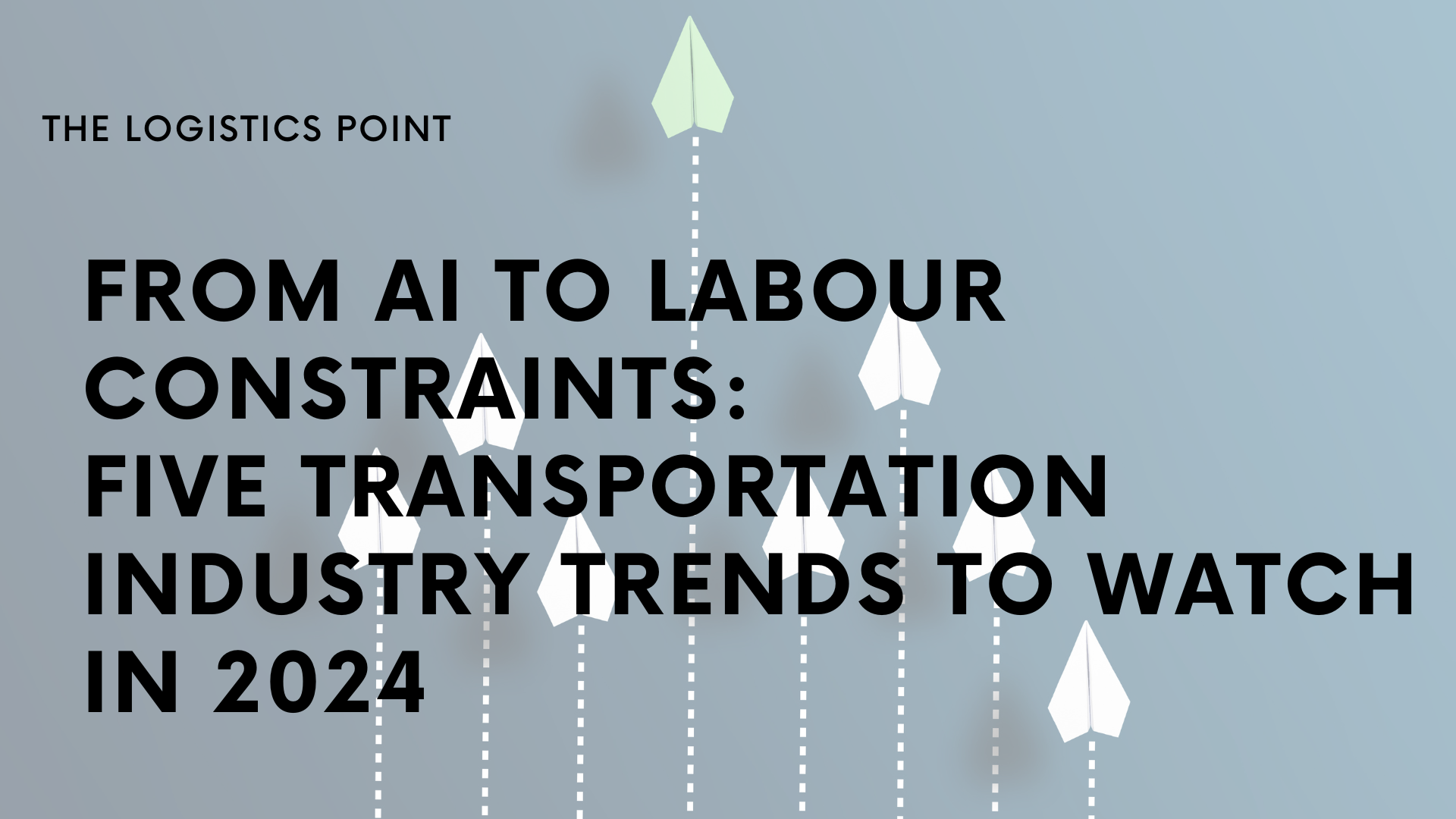By Nikolay Pargov, Chief Revenue Officer at Transporeon
More predictions for 2024 can be found in our January 2024 edition here.
2023 has been challenging for the global transportation market. Interest rates rose sky-high to combat inflation, leaving many economies teetering on the brink of a recession. Meanwhile, load givers and receivers are again prioritising cost-cutting following several years of disruption, which left them laser-focused on building resilient supply chains to rebalance inventories with demand.

In H1 of 2024, global growth will continue to be sluggish, with signs of recovery in H2. However, this doesn’t mean the logistics transportation industry should expect ‘more of the same’. Societal and geopolitical upheavals – not to mention new technologies like generative AI – mean the sector is in constant flux.
With that in mind, here are five transportation industry trends to watch in 2024.
1. The hot topic: Generative AI
While 2023 was a year of AI hype, in 2024, companies will start translating this excitement into action. This typically means creating a company-wide AI strategy and risk framework.
Initial AI use cases will likely involve automating internal processes and/or using past data to make future predictions. Autonomous procurement tools – which use AI, ML and applied behavioural science to drive efficiency, develop shipper and carrier profiles, calculate price predictions and make offers – are just one example.
In 2024, we’ll also see companies experimenting with conversational interfaces to streamline processes and save employee time. However, this use case is still in its infancy.
2. On the rise: Seamless tech ecosystems
Tech stacks in the logistics transportation industry are still woefully fragmented, which prevents companies from unifying data and driving efficiencies. Though digital transformation has been slow, more industry leaders now recognise the value of highly integrated software ecosystems that enable seamless workflows between systems and personas (even across multiple companies). Transporeon’s 2024 Transportation Pulse Report revealed that 74% of industry leaders believe that becoming more data-driven would position their company for success in the next five years. Meanwhile, 55% and 52% respectively named investing in supply chain visibility technology and accelerating digital transformation as priorities.
The reality is that companies can only extract maximum value from new logistics technology if they also prioritise integration. Real-time visibility – the source of much hype in recent years – is a perfect example. There’s limited value in just seeing a live dot on a screen. However, high quality telematics solutions with accurate mapping can enhance other tools (e.g. dock scheduling) if integrated correctly.
3. Here to stay: Sustainable logistics
Ensuring sustainable logistics is now a top priority, thanks to incoming EU legislation and shareholder, customer and societal pressure. However, implementing ambitious decarbonisation measures is costly, which can be difficult for companies to absorb in a low-price environment in which few shippers are prepared to pay a premium for a more sustainable option (though this number is rising).
For this reason, in 2024, we may see less investment in expensive ‘sustainable hardware’ projects like electric trucks, and a greater focus on a more cost-efficient ‘software-driven’ approach, which minimises carbon emissions by driving efficiency. For example, with the right software, companies can reduce unnecessary dwell times, lower empty mileage, plan more efficient routes, and educate drivers on sustainable driving practices.
In the coming year, we’re also likely to see more companies turning away from carbon offsetting, and instead prioritising tangible carbon reduction measures. Once seen as an ‘easy way out’, the industry has fallen out of love with offsetting, after it emerged that many such schemes don’t deliver on their promise.
4. Stormy seas ahead: Ocean upheaval
We’re at the bottom of the freight cycle across all transport modes. However, with existing overcapacity and many ships currently on order books, ocean may experience more disruption than other modes in 2024 (such as air, where spot rates are already recovering). As ships under construction come into operation, the current price war will likely continue.
In 2024, geopolitics and natural disasters will also shape the fate of ocean. The current Panama Canal drought and missile strikes by Houthi rebels in the Suez Canal – which are forcing vessels to reroute via Cape Horn – are just two examples of disruption lengthening transit times.
From a regulatory perspective, the European Commission’s decision not to extend the legal framework exempting liner shipping consortia from antitrust rules will intensify upheaval as carriers adapt to a new environment.
Lastly, the EU’s Emission Trading Scheme will take effect in January 2024, affecting all inbound, outbound, and transshipment vessel movements. Among other measures, it will tax inbound and outbound transshipments at 100% if the ports are within 300 miles of their origin or destination. This will encourage shipping carriers to choose transshipment ports outside the 300-mile zone.
5. Easing, temporarily: The driver shortage
The global logistics transportation industry is battling a significant driver shortage. In 2024, the immediate pressure will subside as capacity continues to exceed demand. However, this doesn’t mean shippers and carriers should ‘let sleeping dogs lie’.
To attract a future labour force, smart companies will continue to invest in measures to tempt new workers into the industry in 2024. This includes lobbying governments to lower the age requirement for HGV drivers and widening the appeal of truck driving by creating an enabling environment for women – such as by implementing trailer door detectors and remote locking systems to prevent crime during overnight stops.
At the same time, research shows that increasing active driving time by just 18 minutes daily could significantly alleviate the driver shortage (MIT Center for Transportation and Logistics). The best way to do this is to invest in logistics technology to drive efficiency. For instance, real-time ETA tools eliminate load and unload waits, while digitising consignment notes saves time by reducing paperwork.
Expect the unexpected
Difficult market circumstances are often the greatest innovation drivers. This is what we’re likely to see in 2024. Challenges like decarbonisation, labour shortages and downward price pressure will only accelerate digitalisation. For instance, implementing connected tech ecosystems will enable companies to grab market share early in the recovery cycle in H2 2024. Meanwhile, technologies like generative AI will allow them to scale quickly without hiring additional resources.
Overall, companies that take a thoughtful, measured and proactive approach to technology are likely to come out on top next year.



